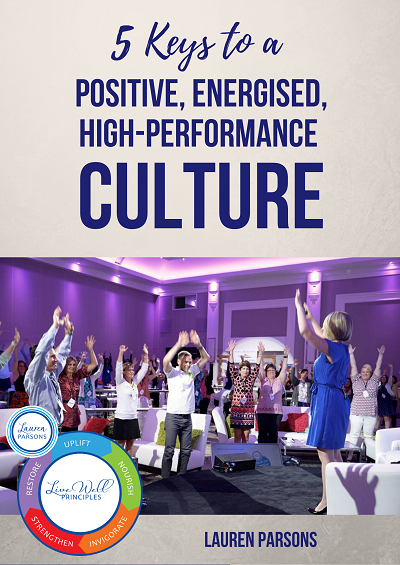Science has proven that success does not lead to happiness, but in fact the opposite is true. Happiness has a profound effect on brain function and significantly increases individual performance, creating greater business success. Businesses that take a holistic approach to staff wellbeing, boosting happiness will enjoy a competitive advantage that improves staff engagement as well as their bottom line.
Depression is a widespread problem, with 1 in 5 people reportedly being affected, creating serious consequences for both individuals and workplaces. Employers have a responsibility under Health and Safety law to manage stress and provide a positive workplace environment that does not cause undue stress. Businesses need to look at how they can reduce stress and boost happiness among staff in order to have calm, resilient fully functioning team members.
One of the best solutions to depression, anxiety, and workplace stress is to take a positive and preventative approach. Rather than simply treating acute challenges (symptoms) as they occur, a proactive approach focuses on the underlying causes, overcoming issues before they arise. It sets individuals and businesses up for success by creating a culture where people can flourish.
Positive psychology is the science of how to make individuals, businesses and communities thrive. It focuses not just on helping sick people become well, but on helping well people become extraordinary. Martin Seligman a pioneer of positive psychology proved the benefits of people enhancing their strengths and happiness, leading to greater success.
International positive psychology expert Shawn Achor explains that the commonly accepted belief that success leads to happiness is flawed. It is in fact, the reverse.
As we become happier, we become more successful.
Achor’s research has proven that increased happiness leads to a 23% reduction in stress, 39% improvement in health and 31% improvement in productivity. Our brains function significantly better in positive mood than in negative, neutral or stressed.
Happiness leads to increased cognitive function, improved problem solving ability, increased memory and retention, higher accuracy and more creativity. All of these things give staff members a huge advantage, allowing them to perform at their peak.
Because employees ultimately determine their company’s success (or lack thereof) by employing positive psychology techniques in the workplace, a business can gain that advantage across the board and see incredible team and company performance.
In working with businesses over the years, I have found that taking a holistic approach is the key to seeing sustained success. Happy people work smarter and produce significantly better results. They also stick with a company for longer and are more engaged in achieving its vision.
The following five strategies help to increase individual happiness, so your staff can be firing on all cylinders, delivering peak performance and driving your business forward.

1. Practise Thankfulness
Often managers are inclined to notice when things go wrong more than when they go right. A disgruntled customer or piece of broken equipment tend to get our attention, but often people doing day to day tasks well gets missed, even though these are fundamental to ongoing success.
Create a management culture where leaders focus on catching people doing things right and thank them on the spot. Immediate and specific feedback is shown to reinforce positive behaviour and greatly increase motivation. People do more of what they are thanked for. This practise also builds trust, improving relationships, meaning staff will spend less time worrying and will be quicker to clarify instructions with their manager when necessary.
Try out this unique idea to ramp up public positivity and practise thankfulness collectively. In team meetings, get each staff member to award a “star of the week” to any other team member explaining why that person merits it. Set up a star chart, get some gold star stickers and link in a reward once people reach 10 or 20 stars.
This process creates positivity on many levels both during and in between meetings. Each staff member pays more attention to their colleagues and how they add value. Team members are naturally more inclined to help each other out as they (even subconsciously) want to be more likely to receive stars. People feel valued and appreciated hearing colleagues compliment them directly. Public praise also fulfils the need for public recognition that many people crave.

2. Promote Movement
Our bodies are designed to move. Exercise is proven to increase short and long-term happiness. Studies also show that sitting down for extended periods (6 or more hours a day) is more hazardous for our health than smoking cigarettes. Experts recommend for every hour that we sit that we should get up and move for a few minutes. In an open plan workspace however, this can be a challenge if it’s not an accepted part of the team culture.
Senior leaders need to set the example and normalise movement in the workplace. Encourage active commuting, normalise regular movement, offer standing or adaptable desks and create active spaces in or near to your staff room. Set up ping pong tables or have tennis balls and resistance bands available. Encourage staff to get into daylight and to play, both fantastic ways to boost mood.
Have standing or walking meetings which not only promote health and boost energy, they also save time being more focused and active. Notes can be taken via dictaphone technology.
Another unique idea to try, is nominating an “active advocate” for each day and give them a bell. Each time that they ring the bell everyone gets up and reaches to the roof, does a one minute of deskercise, stretches, shares laughter then gets back to their task. This fun approach instantly boosts happiness and leads to greater connection through acknowledgement, eye contact and shared experience.

3. Recharge in Rhythm
Teach staff to tune into their internal body clock and pay attention when it signals them to take a break. This needs to be led as a companywide culture. It is very common for people to fall into the trap of working harder not smarter because they perceive taking any sort of break as slacking off, when in fact it is the break that can give you breakthroughs in performance.
We all experience ultradian rhythms throughout the day which are regular cycles where we have approximately 90 minutes upswing when performance peaks followed by 10-15 minutes down swing when the brain needs to rest, restore, do its ‘filing’ and get ready for the next upswing.
When we push through this much needed break, (say if we have a deadline looming and a report to write for example), the body will go into fight or flight mode pushing through with a burst of adrenaline. This is acceptable from time to time, however if we continue this day in and day out, we reach a chronic state of stress which has serious health consequences.
To harness the power of your ultradian rhythms, simply notice when you become distracted, tired, thirsty, hungry or fidgety. These are all signs you need a break from what you are doing.
To recharge, take a break and change your body state. Ideally this would mean reclining or lying down and practising deep diaphragmatic breathing for 5-10 minutes. If that’s not possible, spend a few minutes outside, standing or walking around (if you’ve been sitting), have a stretch and breathe deeply.
Once you return to your work you will be much more focused, your brain will be sharper allowing you to complete your work faster and with more accuracy and creativity. All saving time and making you more productive than when you ‘push on through’.

4. Encourage Random Acts of Kindness
Create a positive culture around helping others in unexpected ways. Champion this among staff and encourage them to do RAKs in and outside of work not just for kindness sake but also to boost happiness.
You can never give a gift without getting something back yourself. As people give out RAKs they will feel that deep level contentment which keeps them in a positive brain state. RAKs between staff members also deepen social connection which is one of the key indicators of long term happiness.
Empower staff with the ability to go the extra mile for customers. Be clear and specific about the delegated authority they have so that they can be responsive to client needs without having to check in with management. This will create wow moments for customer which will enhance your company’s overall brand and reputation.

5. Adopt an Attitude of Gratitude
Gratitude is an instant cure for a bad mood, stress and worry. As our brains aren’t able to focus on two things at once, when we practise gratitude our perspective shifts and everything changes. Stress hormones decrease, growth hormones increase and muscles relax. It even transforms the way we move, breathe and interact with others.
Practising gratitude for as little as two minutes a day can re-programme the brain in just three weeks by strengthening brain pathways making us more optimistic over the long term.
Some two minute exercises to embrace daily gratitude include;
- Casting grateful thoughts back and forwards
At the start of the day think back to one thing that you are thankful for from the day before, then cast your mind forward one thing you are looking forward to that day.
- Sharing grateful words with others
Choose a regular time to tell someone the thing you are most grateful for that day. This could be at work with a colleague, over the phone with a friend or as a family at the dinner table. Take turns to describe in detail the thing you are most grateful for and explain how it made you feel and why. This allows your brain to replay the scene and doubles your happiness factor (as the brain doesn’t distinguish between the real and replayed version.)
- Journaling
At the end of the day write down a list of all the things you are thankful for. This has a profound effect on happiness as it replays the positives, keeps you focused on more of what you want and gives you a reference to look back on which can be handy in challenging times.
Encourage your staff to select one strategy that most appeals to them and start using it every day for a week. They will see immediate and significant changes in how they feel creating a positive spiral leading to even more gratitude, happiness and success.
What some help creating a Positive, Energised, High-Performance Culture in your workplace?
To get started with some practical steps to put in place to boost the health and wellbeing of your team, download a complimentary copy of my eBook 5 Keys to a Positive, Energised, High-Performance Culture.
Simply enter your details here so we can email it out to you.

It will equip you with checklists of tips and ideas you can implement straight away to help your team thrive.
Ready to boost your team’s wellbeing?
For further assistance to boost your team’s energy and productivity, schedule a time for a chat or a complimentary workplace wellbeing insight session with Lauren.

Your thoughts?
Do you already use golden hours or synchronize your staff work flows?
Please leave a comment below…
[i] https://blog.rescuetime.com/work-life-balance-study-2019/
[ii] https://www.ted.com/talks/manoush_zomorodi_how_boredom_can_lead_to_your_most_brilliant_ideas
[iii] https://hbr.org/2012/04/the-new-science-of-building-great-teams
[iv] http://www.shawnachor.com/the-books/the-happiness-advantage/
[v] https://www.ted.com/talks/margaret_heffernan_why_it_s_time_to_forget_the_pecking_order_at_work
Share this Post
